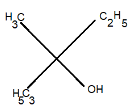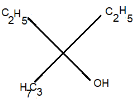
Ethyl ester
A.

B.

C.

D.





Answer
460.5k+ views
Hint:Esters as we know are the close relatives of aldehydes, ketones and carboxylic acids. They consist of a carbonyl group attached directly to an alkoxide (OR) group. Esters reacts with the organometallic compound (Grignard reagents) in the similar way as they react with aldehyde and ketones. But their mechanism is a little different.
Complete step-by-step answer:In the question, we are given with ethyl ester and this has to be reacted with Grignard reagent. We should also note that Grignard reagent is in excess, which means there are multiple moles of Grignard reagent available.
Let us discuss in brief what exactly the reaction is.
Firstly, 1 mole of Grignard reagent will react with ester to form a ketone. The ketone thus formed reacts with another mole of Grignard reagent to yield tertiary alcohol after protonation.
Let us now see the detail mechanism of the reaction:
Step 1: The given Grignard reagent
Step 2: This step is the step of elimination reaction. The intermediate so formed, has a good leaving group
Step 3: The ketone (acetone) so formed reacts with another mole of Grignard reagent to bring out the addition reaction. In this step, the same process of step 1 is repeated. That is a C-C new bond is formed and C-O bond is broken. As a result. a tertiary alkoxide is produced.
Step 4: Finally, the protonation of this tertiary alkoxide forms tertiary alcohol
(
The diagrammatic representation of complete reaction is given below:

The acetone thus formed will react as follows:

Therefore, the correct option is A.
Note: It should be noted that it is not practically feasible to isolate and obtain mere a ketone by the reaction of ester with only one mole of the available Grignard reagent. If we want to isolate ketone then this can be carried out with other organometallic reagents, for example organolithium reagent.
Complete step-by-step answer:In the question, we are given with ethyl ester and this has to be reacted with Grignard reagent. We should also note that Grignard reagent is in excess, which means there are multiple moles of Grignard reagent available.
Let us discuss in brief what exactly the reaction is.
Firstly, 1 mole of Grignard reagent will react with ester to form a ketone. The ketone thus formed reacts with another mole of Grignard reagent to yield tertiary alcohol after protonation.
Let us now see the detail mechanism of the reaction:
Step 1: The given Grignard reagent
Step 2: This step is the step of elimination reaction. The intermediate so formed, has a good leaving group
Step 3: The ketone (acetone) so formed reacts with another mole of Grignard reagent to bring out the addition reaction. In this step, the same process of step 1 is repeated. That is a C-C new bond is formed and C-O bond is broken. As a result. a tertiary alkoxide is produced.
Step 4: Finally, the protonation of this tertiary alkoxide forms tertiary alcohol
(
The diagrammatic representation of complete reaction is given below:

The acetone thus formed will react as follows:

Therefore, the correct option is A.
Note: It should be noted that it is not practically feasible to isolate and obtain mere a ketone by the reaction of ester with only one mole of the available Grignard reagent. If we want to isolate ketone then this can be carried out with other organometallic reagents, for example organolithium reagent.
Latest Vedantu courses for you
Grade 11 Science PCM | CBSE | SCHOOL | English
CBSE (2025-26)
School Full course for CBSE students
₹41,848 per year
Recently Updated Pages
Master Class 12 Business Studies: Engaging Questions & Answers for Success

Master Class 12 English: Engaging Questions & Answers for Success

Master Class 12 Social Science: Engaging Questions & Answers for Success

Master Class 12 Chemistry: Engaging Questions & Answers for Success

Class 12 Question and Answer - Your Ultimate Solutions Guide

Master Class 11 Economics: Engaging Questions & Answers for Success

Trending doubts
Draw a labelled sketch of the human eye class 12 physics CBSE

a Tabulate the differences in the characteristics of class 12 chemistry CBSE

Which one of the following is a true fish A Jellyfish class 12 biology CBSE

Why is the cell called the structural and functional class 12 biology CBSE

Differentiate between homogeneous and heterogeneous class 12 chemistry CBSE

Write the difference between solid liquid and gas class 12 chemistry CBSE




